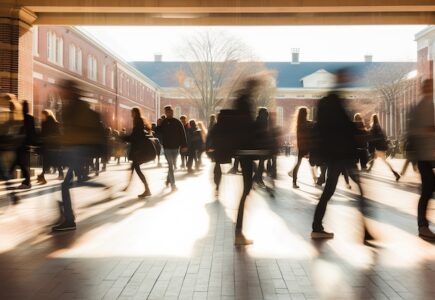
By Paul Timm
Crime Prevention Through Environmental Design (CPTED) principles center around the idea that crime is deterred most effectively by making crimes difficult to commit. By employing these strategic principles, educational facilities can introduce a blend of natural, practical, and physical solutions to enhance campus safety and deter potential criminal behavior.
Growing safety concerns have led educational institutions to implement visible security measures such as weapons detection systems and closely monitored access points. However, these noticeable security features may adversely affect the school environment and how students feel about safety. Crime Prevention Through Environmental Design (CPTED) provides a cost-effective and intelligent approach to enhance school safety. It focuses on utilizing natural surveillance, natural access control, and proper maintenance to create a safer school environment. By emphasizing these elements, CPTED not only deters potential threats but also fosters a positive perception within the school community, making students, staff, and visitors feel more secure and comfortable on campus.
The challenge for facility leaders lies in balancing effective security measures within constrained budgets and resources. Establishing a safety planning team consisting of teachers, administrators, IT personnel, emergency responders, students, and other relevant stakeholders is essential. Through regular meetings, this team can collectively address security concerns, share essential information, and educate others about school facility safety to better prepare for and respond to emergencies. Collaboration and education stand as pivotal elements in ensuring the safety of schools.
Provide Natural Surveillance And Visibility
Facility managers in K-12 schools can significantly improve safety and the overall experience by integrating CPTED design strategies that target the site and exterior of the premises. This involves the deliberate design of landscapes without tall shrubs or low tree limbs that might obstruct visibility and strategically placing physical elements to optimize sightlines. For instance, maintaining an unobstructed view between the school’s front doors and the main office, or positioning vegetation away from classroom windows.
All campus facilities need to be well lit, even the outdoor environments. Updates to lighting, controlled access points and increased security can enhance campus safety. Sufficient lighting is necessary for people to see and be seen. Ensuring the presence of good lighting is crucial specifically in parking lots, along walkways and at building entrance points. From a security point of view, lighting that is strategically placed can have a substantial impact on reducing the fear of crime. LED lights are most popular because they are brighter, more efficient and ensure areas comply with foot-candle standards.
Layer Access Management
It’s critical to develop a strategic way into the school or campus building with clear signage, real or symbolic barriers, and ultimately limited access and locked, layered doors. For additional security, many find success in the deployment of an electronic access control system equipped with video surveillance and a credential reader featuring an intercom system. Ideally, too, facilities are leveraging electronic locks that require a card or PIN to protect specific rooms or sensitive/valuable storage.
When fostering a community of culture and safety, these simple deliberate facility designs not only reduce hiding spots but also decrease unsafe feelings. Intentional planning of facility leaders, administrators and community members encourages collaboration to create an environment where safety is prioritized, and everyone has peace of mind.
Maintain Physical Appearance
It’s important to consider various facility-based elements that can enhance security and safety protocols within school buildings. The maintenance and the ‘image’ of an area can have a major impact on whether it will become targeted. By keeping areas neat and clean perpetrators are less likely to come around or have tools around to harm/vandalize.
Facility managers committed to proper maintenance help create a sense of ownership that can be a vital factor in making a place safer. Removing graffiti quickly, keeping restrooms clean and in good repair and updating security technology visibly demonstrates attentiveness and care that not only ensures optimal security but extends the life of the products.
Future campus growth should also be discussed as part of campus safety strategies to ensure the current project’s infrastructure flows into future expansion and renovation plans. Schools often struggle to get “personal investments” from students and staff members. It’s important to recognize the role of the school culture in promoting safety. Actions that may seem benign, like propping open a door, can inadvertently compromise security. A commitment to safety at both the organizational and individual levels is essential for creating a secure and protected school environment.
Prioritizing Safe Schools Every Week
Navigating the balance between school safety and security remains an ongoing challenge that needs constant attention. This shared responsibility involves the collective efforts of students, parents, school personnel, as well as community members. Ensuring a safe and conducive learning environment requires a united commitment from all stakeholders, emphasizing the collaborative role each party plays in upholding the well-being of our schools.
Implementing the principles of CPTED doesn’t need to be expensive. When combined with appropriate security technology, these strategies can significantly improve the safety and security of your school building and premises. CPTED design goes beyond cost-effectiveness; it plays a fundamental role in reducing victimization, fostering a sense of community and belonging on campus, deterring potential criminal activities, and alleviating fear of crime for both staff and students. By seamlessly integrating these approaches, schools can create a safer and more inclusive environment for everyone.
For comprehensive school safety best practices, facility leaders are encouraged to consult The Partner Alliance for Safer Schools (PASS). It provides the most thorough information on securing school facilities. PASS recommends beginning with a self-assessment to evaluate your current campus situation. From there, explore ways to integrate these security strategies into your existing layers of campus safety and security.
 Timm, the Director of Education Safety for Allegion, is a board-certified Physical Security Professional (PSP), author of “School Security: How to Build and Strengthen a School Safety Program,” and a nationally acclaimed expert in physical security. He is also a member of PASS, CSC, ASIS International’s School Safety & Security Council and IASBO (Illinois Association of School Business Officials) Risk Management Committee.
Timm, the Director of Education Safety for Allegion, is a board-certified Physical Security Professional (PSP), author of “School Security: How to Build and Strengthen a School Safety Program,” and a nationally acclaimed expert in physical security. He is also a member of PASS, CSC, ASIS International’s School Safety & Security Council and IASBO (Illinois Association of School Business Officials) Risk Management Committee.





















![[VIDEO] Collect Asset Data at the Speed of Walking a Building](https://facilityexecutive.com/wp-content/uploads/2024/02/maxresdefault-324x160.jpg)